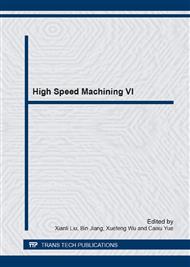p.175
p.180
p.186
p.191
p.197
p.203
p.208
p.214
p.221
Study Chip Breaking Experimental and Optimal Design of Tool for Machining Cylindrical Shell Material
Abstract:
Large cylindrical shells are widely used in many areas of aerospace, petroleum chemical industry and nuclear power, etc. The main material of large cylindrical shells is 2.25Cr-1Mo-0.25V. In the process of heavy-duty cutting cylindrical shell material, the removal rate is high, and machine condition is rough, because the viscosity of big cylindrical shell material, the large chips not easy to be broken, and the tool and workpiece often entangled affect the machining efficiency. Researh and development to apply heavy cutting under the condition of high performance cutting tool has great practical significance, because of at the same time for heavy cutting tool is less in china. This paper uses the cutting performance experiment aiming to cylindrical shell material used in different three-dimensional groove blades and studies the range of different blades broken chips and the influence of three-dimensional groove on breaking effect. The chips form of cutting cylindrical shell material is summarized. And chip-breaking groove of the best performance is optimized. The paper designs of the new heavy-duty vehicles blade well and vertfies the good effect of the new heavy-duty cutting the breaker by the results of 3 d finite element simulation. The paper provides basis for designing heavy-duty cutting.
Info:
Periodical:
Pages:
197-202
Citation:
Online since:
July 2014
Authors:
Price:
Сopyright:
© 2014 Trans Tech Publications Ltd. All Rights Reserved
Share:
Citation:


